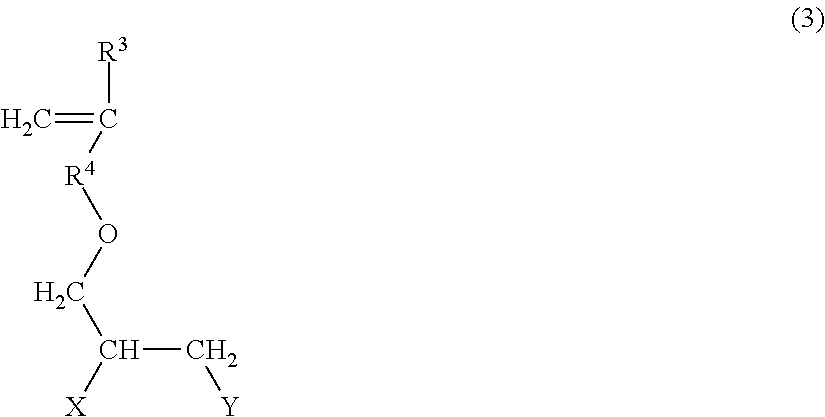Sulfonate group-containing polymer and method of producing the same
a technology of sulfonate group and polymer, which is applied in the direction of detergent compositions, detergent compounding agents, chemistry apparatus and processes, etc., can solve the problem of more soil or hard components in the water, and achieve the effect of convenient handling
- Summary
- Abstract
- Description
- Claims
- Application Information
AI Technical Summary
Benefits of technology
Problems solved by technology
Method used
Image
Examples
example 1
[0159]A 500 ml glass separable flask equipped with a reflux condenser and a stirrer was charged with pure water (49.7 g) and Mohr's salt (0.010 g), and the temperature was raised to 85° C. while stirring. Then, 80% acrylic acid (112.5 g) (hereinafter, abbreviated as 80% AA), a 40% aqueous solution (54.9 g) (92 mmol) of sodium 3-allyloxy-2-hydroxypropanesulfonate (hereinafter, abbreviated as 40% HAPS), a 80% aqueous solution (90.0 g) of an isoprenol-ethylene oxide 10 mol adduct (hereinafter, abbreviated as 80% IPN10), 15% sodium persulfate (30.2 g) (hereinafter, abbreviated as 15% NaPS), 35% sodium hydrogen sulfite (12.9 g) (hereinafter, abbreviated as 35% SBS), and pure water (50.9 g) were added dropwise from different nozzles. The addition times for the respective solutions were 180 min for 80% AA, 150 min for 40% HAPS, 90 min for 80% IPN10, 190 min for 15% NaPS, and 175 min for 35% SBS and pure water. All the solutions began to be added dropwise at the same time. The temperature o...
example 2
[0160]A 500 ml glass separable flask equipped with a reflux condenser and a stirrer was charged with pure water (74.1 g) and Mohr's salt (0.010 g), and the temperature was raised to 85° C. while stirring. Then, 80% AA (121.5 g), 40% HAPS (65.9 g) (111 mmol), a 60% aqueous solution (102.0 g) of an isoprenol-ethylene oxide 25 mol adduct (hereinafter, abbreviated as 60% IPN25), 15% NaPS (20.6 g), and 35% SBS (11.0 g) were added dropwise from different nozzles. The addition times for the respective solutions were 180 min for 80% AA, 150 min for 40% HAPS, 150 min for 60% IPN25, 190 min for 15% NaPS, and 175 min for 35% SBS and pure water. All the solutions began to be added dropwise at the same time. The temperature of the content was kept at 85° C. until the addition dropwise of 80% AA was finished. Further, the temperature was kept the same for 30 min after the addition dropwise of 80% AA was completed so that the reaction solution was aged, and the polymerization was completed. After ...
example 3
[0161]A 500 ml glass separable flask equipped with a reflux condenser and a stirrer was charged with pure water (83.1 g) and Mohr's salt (0.013 g), and the temperature was raised to 85° C. while stirring. Then, 80% AA (198.0 g), 40% HAPS (25.9 g) (44 mmol), a 60% aqueous solution (31.1 g) of an isoprenol-ethylene oxide 50 mol adduct (hereinafter, abbreviated as 60% IPN50), 15% NaPS (30.1 g), and 35% SBS (10.3 g) were added dropwise from different nozzles. The addition times for the respective solutions were 180 min for 80% AA, 150 min for 40% HAPS, 150 min for 60% IPN50, 190 min for 15% NaPS, and 175 min for 35% SBS and pure water. All the solutions began to be added dropwise at the same time. The temperature of the content was kept at 85° C. until the addition dropwise of 80% AA was finished. Further, the temperature was kept the same for 30 min after the addition dropwise of 80% AA was completed so that the reaction solution was aged, and the polymerization was completed. After co...
PUM
| Property | Measurement | Unit |
|---|---|---|
| temperature | aaaaa | aaaaa |
| temperature | aaaaa | aaaaa |
| temperature | aaaaa | aaaaa |
Abstract
Description
Claims
Application Information
 Login to View More
Login to View More - R&D
- Intellectual Property
- Life Sciences
- Materials
- Tech Scout
- Unparalleled Data Quality
- Higher Quality Content
- 60% Fewer Hallucinations
Browse by: Latest US Patents, China's latest patents, Technical Efficacy Thesaurus, Application Domain, Technology Topic, Popular Technical Reports.
© 2025 PatSnap. All rights reserved.Legal|Privacy policy|Modern Slavery Act Transparency Statement|Sitemap|About US| Contact US: help@patsnap.com



